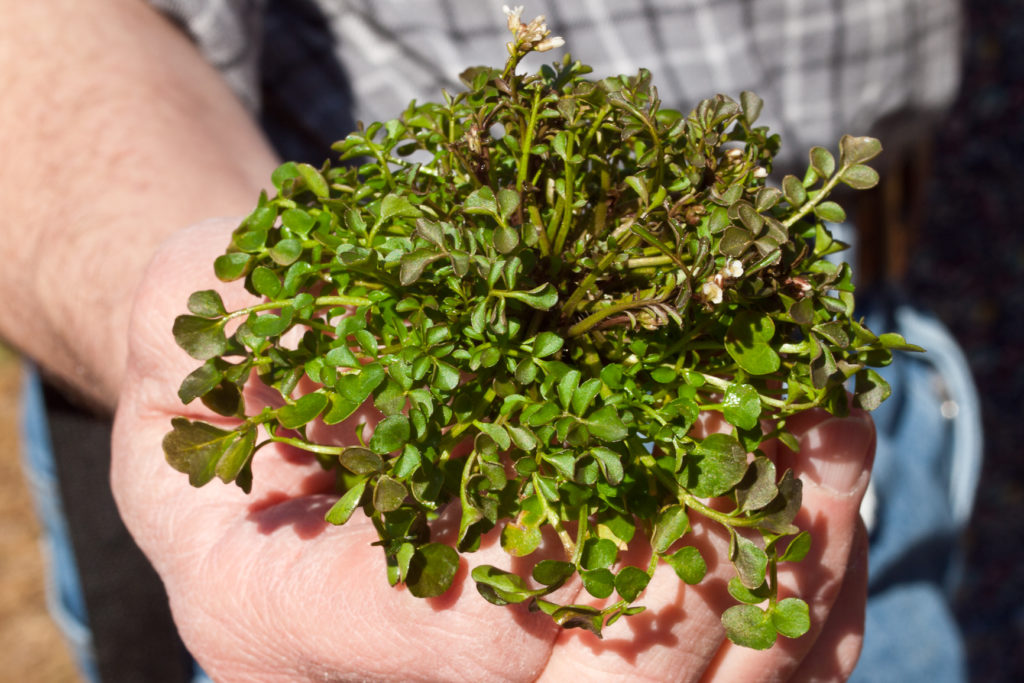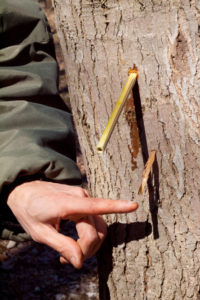
The concept of foraging brings to mind a post-apocalyptic landscape and survivalist rations, so I wasn’t expecting to start a foraging walk on the manicured lawn of a lush suburban park just north of Washington, D.C.
I squatted on the lawn, watching a bearded man dig through the thick ground cover with a small spade until he pulled up a clump of green by the roots.
“Bittercress,” he said. He pulled off a sprig and put it in his mouth, then passed the rest around to my fellow foragers. “Try a piece. It’s got a little bite, but it’s amazing stir-fried.”

I pulled off a sprig and put it in my mouth, surprised by both its sharpness and its raw freshness. Forager Matt Cohen encouraged us each to paw through the grass in search of our own clump of bittercress, helpfully pointing out the important details: several stalks all growing from a central point, five-to-nine paired leaflets, and a single leaf at the tip of the stalk.
Cohen’s quest expanded into the rest of the park lawn, uncovering chickweed, dandelions, onion grass and garlic mustard. He crushed the leaves of the garlic mustard and encouraged us all to do the same: The aroma is unmistakable. It’s also one of the few clear signs that a plant is safe to eat, Cohen explained. If it smells like garlic or onion, it’s usually not poisonous. In fact, it can be delicious: “Garlic mustard makes an incredible pesto,” he said.
Cohen began his career as a forager 20 years ago, when he abandoned his career as a computer programmer to become a full-time landscaper and avid amateur wild-plant forager. He counsels people to begin foraging as he began, by finding edible plants in the most common areas, suburban lawns.
Cohen supplied us with specific methods for identifying edible plants, but also gave us bigger-picture tips for someone just beginning to investigate wild foraging. Like so many things, foraging begins with the concept: location, location, location.
Matt Cohen’s Top Five Location Tips for Beginning Foragers:
- Start in your own backyard if you have one. Learn the most common weeds and find out which ones are edible.
- Next, move on to vacant lots, waste areas and spots that are neglected. There are lots of weeds there, but be careful to avoid possible sources of contamination, such as areas frequented by dogs and dog walkers.
- Learn about invasive plants, which are usually free for the taking. Public park officials often hire volunteers to remove invasive species from the local ecosystem. You can help the environment while creating a delicious meal.
- If you live in a city, check out community gardens. Gardeners are often excited to have help with the never-ending task of weeding.
- Always know the land you want to forage and get permission from the owner.

We walked further into the Maryland woods in search of wilder fare. We passed a large patch of snow, when suddenly Cohen excitedly spun around. “Skunk cabbage!” he said. The foul-smelling purplish plant poking through the snow heralds the coming of spring.
Further in the woods Cohen pointed out a series of small, bright green shoots, spreading out in the undergrowth. He explained that its common name is spring beauty (Claytonia virginica), but foragers have a different name for it. They call it fairy spuds. Cohen revealed why when he showed us the diminutive potato that dangled within its roots. It’s a wild food eaten by Native Americans and early settlers alike.

Then Cohen stopped at a bare, leafless birch tree. Using a pocketknife, he drilled a small hole into the trunk, then stuck a small bamboo stick into the hole. We waited patiently, staring at the unmoving stick, until a small crystal drop of birch sap appeared at its end. We each took a turn touching our fingers to each drop as it appeared, then tasting the wet sweet sap.
Cohen then revealed a steel maple tap he had placed in a maple tree just an hour before. Beneath the tap was a jar nearly overflowing with a clear liquid. We passed the jar around and when it came to me, I lifted the light clear liquid and drank. It was like fresh spring water, with an edge of sweetness. It was one of the most amazing things I’d ever tasted — water from inside a tree.
It brought back to me the recent cross-country move I had made, from warm, always-sunny Southern California to the bare, early-spring chill of the East Coast. The lushness of Los Angeles may seem alluring, but it’s easy to become accustomed to abundance and take it for granted. In a world with winter, the first stalks of skunk cabbage are greeted with pleasure. Tiny clumps in the lawn can become a stir-fried delicacy. And deep inside a tree, gathering all winter, a hidden fountain of water courses through the trunk, sweet enough to turn into pancake syrup.
My new home is full of surprises.
Bittercress Stir-Fry
Courtesy of Matt Cohen
Ingredients
1 tablespoon olive oil
½ cup field garlic (also known as onion grass)
4 cups bittercress
1-2 tablespoons tamari
Directions
1. Heat up the olive oil over medium heat.
2. Chop field garlic bulb and greens.
3. Cook for a few minutes in olive oil.
4. Finely chop bittercress and add to field garlic.
5. Add tamari to taste.
6. Cook another 5 minutes and serve as a side dish.
